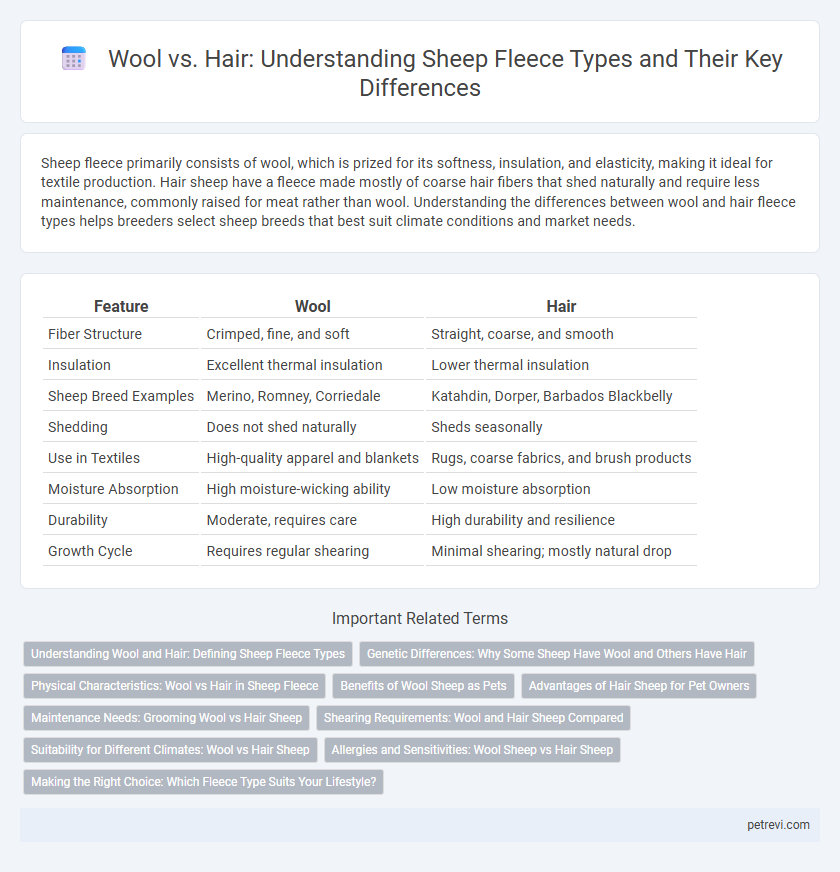Sheep fleece primarily consists of wool, which is prized for its softness, insulation, and elasticity, making it ideal for textile production. Hair sheep have a fleece made mostly of coarse hair fibers that shed naturally and require less maintenance, commonly raised for meat rather than wool. Understanding the differences between wool and hair fleece types helps breeders select sheep breeds that best suit climate conditions and market needs.
Table of Comparison
| Feature | Wool | Hair |
|---|---|---|
| Fiber Structure | Crimped, fine, and soft | Straight, coarse, and smooth |
| Insulation | Excellent thermal insulation | Lower thermal insulation |
| Sheep Breed Examples | Merino, Romney, Corriedale | Katahdin, Dorper, Barbados Blackbelly |
| Shedding | Does not shed naturally | Sheds seasonally |
| Use in Textiles | High-quality apparel and blankets | Rugs, coarse fabrics, and brush products |
| Moisture Absorption | High moisture-wicking ability | Low moisture absorption |
| Durability | Moderate, requires care | High durability and resilience |
| Growth Cycle | Requires regular shearing | Minimal shearing; mostly natural drop |
Understanding Wool and Hair: Defining Sheep Fleece Types
Sheep fleece types are broadly categorized into wool and hair, each with distinct fiber characteristics affecting insulation, texture, and usability. Wool fibers are fine, crimped, and elastic, providing superior warmth and moisture-wicking properties preferred for textiles. Hair fibers, coarser and smoother, are shed seasonally and often used for more durable, less insulating materials such as rugs or outerwear.
Genetic Differences: Why Some Sheep Have Wool and Others Have Hair
Sheep fleece type is determined by genetic differences linked to distinct genes controlling hair follicle development and fiber characteristics. Wool sheep possess genes that promote the growth of fine, crimped fibers with high lanolin content, while hair sheep carry genes favoring coarse, straight fibers with minimal lanolin. These genetic variations impact fleece texture, insulation properties, and suitability for different climates and textile uses.
Physical Characteristics: Wool vs Hair in Sheep Fleece
Sheep fleece consists primarily of two types: wool and hair, each with distinct physical characteristics. Wool fibers are fine, crimped, and elastic, providing insulation and moisture-wicking properties, while hair fibers are coarser, straighter, and less flexible, often lacking the insulating qualities of wool. The unique fiber diameter and structure influence fleece softness, warmth, and suitability for textile production, with wool typically preferred for high-quality garments and hair favored for durability and weather resistance.
Benefits of Wool Sheep as Pets
Wool sheep provide a soft, insulating fleece that benefits pet owners by offering natural warmth and comfort, making them ideal companions in colder climates. Their fleece requires regular shearing, which can help maintain skin health and reduce parasites, contributing to overall sheep well-being. Wool sheep also tend to have a calmer temperament compared to hair sheep, enhancing their suitability as gentle and manageable pets.
Advantages of Hair Sheep for Pet Owners
Hair sheep offer numerous advantages for pet owners, including low-maintenance fleece that naturally sheds, eliminating the need for shearing and reducing grooming time. Their fleece is less prone to matting and parasites, promoting healthier skin and minimizing veterinary costs. This easy-care trait makes hair sheep ideal for owners seeking a hassle-free, hypoallergenic companion with minimal wool care.
Maintenance Needs: Grooming Wool vs Hair Sheep
Wool sheep require frequent shearing and regular grooming to prevent matting, lanolin buildup, and parasite infestations, which can otherwise compromise fleece quality. Hair sheep have lower maintenance needs as their coats naturally shed, reducing the risk of tangles and facilitating better parasite resistance without the need for shearing. Proper grooming practices tailored to fleece type optimize sheep health, comfort, and wool production efficiency.
Shearing Requirements: Wool and Hair Sheep Compared
Wool sheep require regular shearing at least once a year to prevent fleece overgrowth, which can cause discomfort and health issues. Hair sheep naturally shed their coat and typically do not need shearing, reducing labor and equipment costs. Shearing wool sheep also produces valuable wool fiber for textiles, whereas hair sheep fleece is primarily used in niche markets or for insulation purposes.
Suitability for Different Climates: Wool vs Hair Sheep
Wool sheep fleece offers superior insulation and moisture-wicking properties, making it ideal for cold and wet climates by retaining warmth even when damp. Hair sheep fleece, with its shorter, coarse fibers, provides better heat tolerance and dries faster, suiting hot, arid environments where overheating and humidity are concerns. Choosing between wool and hair fleece depends on regional climate conditions, influencing sheep comfort and fleece utility for textile applications.
Allergies and Sensitivities: Wool Sheep vs Hair Sheep
Wool sheep produce fleece rich in lanolin and fine fibers, which can trigger allergic reactions and skin sensitivities in some individuals. Hair sheep have fleece resembling human hair, containing less lanolin and fewer irritants, making them a hypoallergenic alternative suitable for sensitive skin. Choosing hair sheep fleece reduces the risk of wool-related allergies while still providing durable fiber for textile use.
Making the Right Choice: Which Fleece Type Suits Your Lifestyle?
Wool fleece, known for its insulating properties and moisture-wicking ability, is ideal for those seeking warmth and durability in colder climates or for crafting textiles. Hair fleece, characterized by longer, coarser strands, suits individuals desiring low-maintenance, hypoallergenic options with natural water resistance. Choosing between wool and hair fleece hinges on lifestyle factors such as climate, allergy considerations, and intended fleece use, ensuring optimal comfort and practicality.
Wool vs Hair for Sheep Fleece Type Infographic

 petrevi.com
petrevi.com